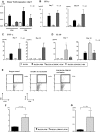Immunization with host-type CD8{alpha}+ dendritic cells reduces experimental acute GVHD in an IL-10-dependent manner
- PMID: 19965670
- PMCID: PMC2810989
- DOI: 10.1182/blood-2009-06-229708
Immunization with host-type CD8{alpha}+ dendritic cells reduces experimental acute GVHD in an IL-10-dependent manner
Abstract
Little is known about the role of active immunization in suppressing undesirable immune responses. Because CD8alpha(+) dendritic cells (DCs) suppress certain immune responses, we tested the hypothesis that immunization of donors with host-derived CD8alpha(+) DCs will reduce host-specific donor T-cell responses. BALB/c T cells from the animals that were immunized with B6 CD8alpha(+) DCs demonstrated, in vitro and in vivo, significantly reduced proliferation and secretion of inflammatory cytokines but showed enhanced secretion of interleukin-10 (IL-10). The responses against third-party and model antigens were preserved demonstrating antigen specificity. The in vivo relevance was further demonstrated by the reduction on graft-versus-host disease (GVHD) in both a major histocompatibility complex-mismatched clinically relevant BALB/c --> B6 model and major histocompatibility complex-matched, minor-mismatched C3H.SW --> B6 model of GVHD. Immunization of the donors that were deficient in IL-10 (IL-10(-/-)) or with CD8alpha(+) DCs from B6 class II (class II(-/-)) failed to reduce T-cell responses, demonstrating (1) a critical role for secretion of IL-10 by donor T cells and (2) a direct contact between the T cells and the CD8alpha(+) DCs. Together, these data may represent a novel strategy for reducing GVHD and suggest a broad counterintuitive role for vaccination strategies in mitigating undesirable immune responses in an antigen-specific manner.
Figures








Similar articles
-
Recipient-Derived Allo-iTregs Induced by Donor DCs Effectively Inhibit the Proliferation of Donor T Cells and Reduce GVHD.Anat Rec (Hoboken). 2019 May;302(5):825-836. doi: 10.1002/ar.23972. Epub 2018 Nov 25. Anat Rec (Hoboken). 2019. PMID: 30312018
-
Preterminal host dendritic cells in irradiated mice prime CD8+ T cell-mediated acute graft-versus-host disease.J Clin Invest. 2002 May;109(10):1335-44. doi: 10.1172/JCI14989. J Clin Invest. 2002. PMID: 12021249 Free PMC article.
-
Host-derived CD8⁺ dendritic cells protect against acute graft-versus-host disease after experimental allogeneic bone marrow transplantation.Biol Blood Marrow Transplant. 2014 Nov;20(11):1696-704. doi: 10.1016/j.bbmt.2014.08.005. Epub 2014 Aug 13. Biol Blood Marrow Transplant. 2014. PMID: 25132527
-
Extracorporeal photopheresis attenuates murine graft-versus-host disease via bone marrow-derived interleukin-10 and preserves responses to dendritic cell vaccination.Biol Blood Marrow Transplant. 2011 Jun;17(6):790-9. doi: 10.1016/j.bbmt.2010.12.712. Epub 2011 Jan 7. Biol Blood Marrow Transplant. 2011. PMID: 21216299 Free PMC article.
-
Pathogenesis of graft-versus-host disease: innate immunity amplifying acute alloimmune responses.Int J Hematol. 2013 Sep;98(3):293-9. doi: 10.1007/s12185-013-1421-x. Epub 2013 Aug 28. Int J Hematol. 2013. PMID: 23982970 Review.
Cited by
-
Bendamustine Conditioning Skews Murine Host DCs Toward Pre-cDC1s and Reduces GvHD Independently of Batf3.Front Immunol. 2020 Jul 16;11:1410. doi: 10.3389/fimmu.2020.01410. eCollection 2020. Front Immunol. 2020. PMID: 32765499 Free PMC article.
-
Interleukin-6 modulates graft-versus-host responses after experimental allogeneic bone marrow transplantation.Clin Cancer Res. 2011 Jan 1;17(1):77-88. doi: 10.1158/1078-0432.CCR-10-1198. Epub 2010 Nov 3. Clin Cancer Res. 2011. PMID: 21047980 Free PMC article.
-
FLT3L and plerixafor combination increases hematopoietic stem cell mobilization and leads to improved transplantation outcome.Biol Blood Marrow Transplant. 2014 Mar;20(3):309-13. doi: 10.1016/j.bbmt.2013.11.024. Epub 2013 Dec 21. Biol Blood Marrow Transplant. 2014. PMID: 24365795 Free PMC article.
-
Host basophils are dispensable for induction of donor T helper 2 cell differentiation and severity of experimental graft-versus-host disease.Biol Blood Marrow Transplant. 2011 Dec;17(12):1747-53. doi: 10.1016/j.bbmt.2011.08.013. Epub 2011 Aug 25. Biol Blood Marrow Transplant. 2011. PMID: 21871863 Free PMC article.
-
Immune regulatory cells in umbilical cord blood and their potential roles in transplantation tolerance.Crit Rev Oncol Hematol. 2011 Aug;79(2):112-26. doi: 10.1016/j.critrevonc.2010.07.009. Epub 2010 Aug 19. Crit Rev Oncol Hematol. 2011. PMID: 20727784 Free PMC article. Review.
References
-
- Nossal GJ. Host immunobiology and vaccine development. Lancet. 1997;350(9087):1316–1319. - PubMed
-
- Banchereau J, Palucka AK. Dendritic cells as therapeutic vaccines against cancer. Nat Rev Immunol. 2005;5(4):296–306. - PubMed
-
- Steinman RM, Hawiger D, Nussenzweig MC. Tolerogenic dendritic cells. Annu Rev Immunol. 2003;21:685–711. - PubMed
-
- Appelbaum FR. Haematopoietic cell transplantation as immunotherapy. Nature. 2001;411(6835):385–389. - PubMed
-
- Welniak LA, Blazar BR, Murphy WJ. Immunobiology of allogeneic hematopoietic stem cell transplantation. Annu Rev Immunol. 2007;25:139–170. - PubMed
Publication types
MeSH terms
Substances
Grants and funding
LinkOut - more resources
Full Text Sources
Research Materials

